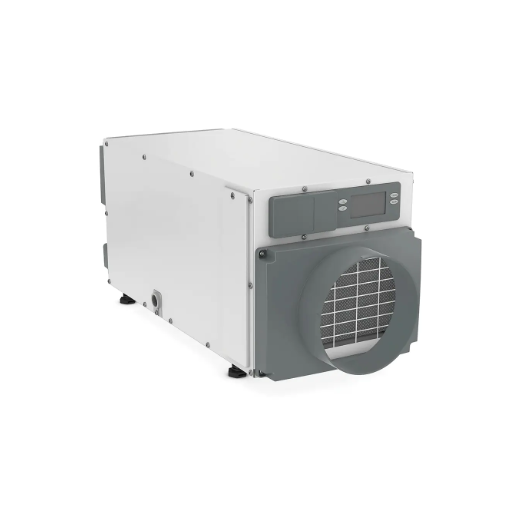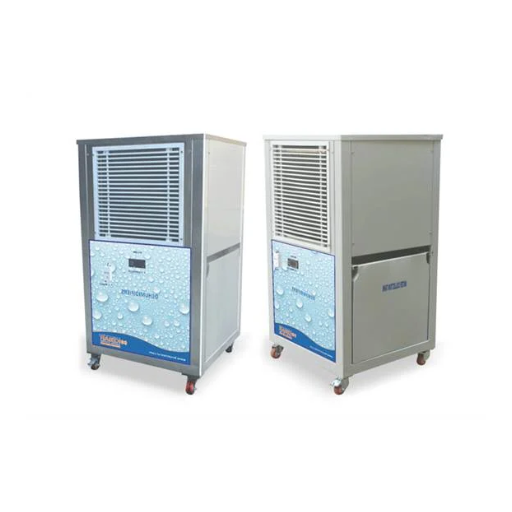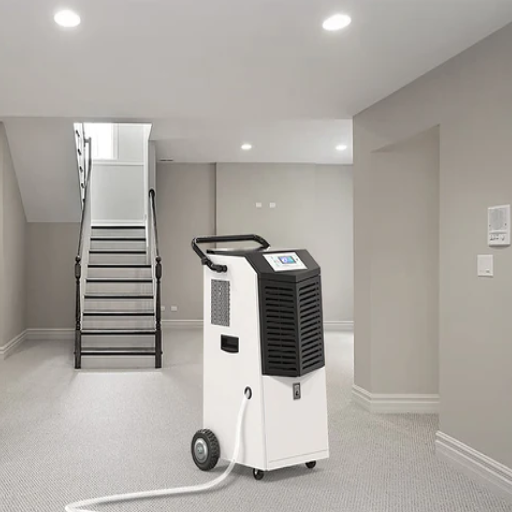Upholding proper indoor air quality is of utmost importance for our comfort and health; one of the most challenging aspects to achieve is managing excess humidity. Aeration of humidity confirms that indoor spaces do not become stuffy, but can actually cause a plethora of problems such as the development of mold, allergens, and damage to furniture or walls. This guide takes a closer look at the functions of dehumidifiers, and how they help reduce the moisture content in the air of a home or office. We will discuss the science behind their operation, the benefits they bring, and practical tips for selecting and maintaining the right dehumidifier for your needs. By the end of this article, you will have an idea of how the use of dehumidifiers helps achieve a quality indoor environment and improves the living standard.
What is a Dehumidifier and How Does it Work?
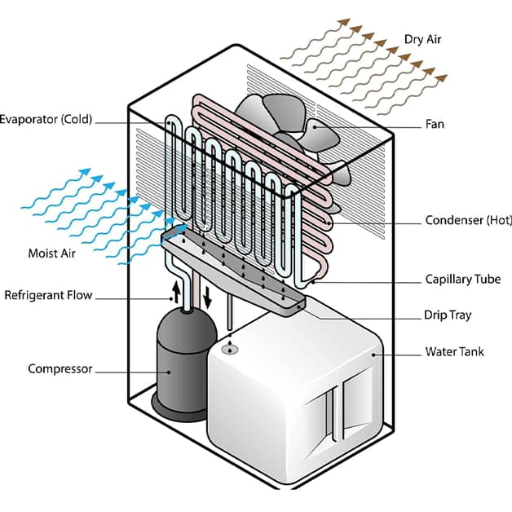
A dehumidifier is a piece of equipment that pulls out surplus moisture from the air. This keeps indoor humidity within the right limits. The dehumidifier draws in humid air using a fan. As the air moves over cold coils, moisture condenses into water droplets. The water is collected into a reservoir and later released while the drier air is pushed back into the room. The process helps eliminate mold and musty odors while enhancing the overall air quality, which minimizes further damage to structural components caused by high humidity levels.
Understanding the Basics of a Dehumidifier
- How does a dehumidifier work?
A dehumidifier collects moist air through the fan, and then sends it over cold coils that condense moisture into water droplets. After the air is dried, the excess water is either stored in a tank or drained through a hose. Finally, the dried air is blown back into the room.
- What are the typical technical parameters to consider?
-
-
- Capacity: Measured in pints per day (e.g., 30-70 pints/day), indicating how much moisture it can remove.
- Coverage Area: Based on square footage (e.g., 500-4,500 sq. ft.), specifying the size of the area it can effectively dehumidify.
- Energy Efficiency: Look for the Energy Star rating to ensure lower power consumption.
- Reservoir Size: Typically ranges from 0.5 to 2 gallons, depending on the model.
- Noise Level: Measured in decibels (dB), with quieter models operating around 50-60 dB.
- Operating Temperature Range: Most units operate between 41°F and 95°F for optimal function.
-
- How Does Dehumidifier Help?
A dehumidifier helps to prevent musty odors, mold, other allergens such as dust mites, and structural damage due to moisture.
With this approach to understanding the Fundamentals alongside the key and relevant technical parameters, it is possible to select a dehumidifier that fits your needs and guarantees a healthier environment indoors.
How Does a Dehumidifier Work to Remove Moisture?
A dehumidifier draws in moisture-laden air using a fan, cools it by passing it over refrigerated coils, and causes the moisture in the air to condense into water droplets. The cooled air is then further dried and heated to a comfortable level before being wafted back into the room, and this resultant dehumidified air is moisture-free. Due to the lower humidity, problems stemming from excess moisture like mold formation and human discomfort are averted. Many modern dehumidifiers also feature integrated hygrometers for effective automated humidity control.
The Difference Between a Dehumidifier and a Humidifier
The two devices, a dehumidifier, and an air humidifier, serve opposing functions in regulating indoor air quality. A dehumidifier lowers humidity levels by absorbing moisture in the air. This is most useful in highly humid environments in which mold, allergens, and structural dampness can become detrimental. A humidifier’s role is to add moisture to the ears and aid in combating issues such as irritation to the respiratory systems, dry skin, and static electricity which all tend to happen in areas with thin air.
It is imperative to think about the RH levels in your vicinity when deciding on either of these devices. The optimal indoor humidity is usually 30%-50%, which is dependent on seasonal fluctuation and personal comfort. Furthermore, it is important to note that dehumidifiers work best at over 50% and humidifiers below 30%. The majority of contemporary machines now come with built-in hygrometers for improved control of indoor humidity.
The moisture removal capability of dehumidifiers, which is classified as the Pints Per Day (PPD) index, is set at 30, 50, or 70 PPD. Their energy efficiency is frequently expressed in terms of the Energy Factor (EF), with higher figures corresponding to greater efficiency. For humidifiers, classification is based on type, i.e. evaporative, ultrasonic, steam, etc., along with their water output, which is measured in gallons per day.
Both devices are essential to ensure optimum living and working conditions of comfort and health. The decision to purchase one or the other rests on the identification and fulfillment of particular indoor air requirements.
Why You Need a Dehumidifier in Your Home
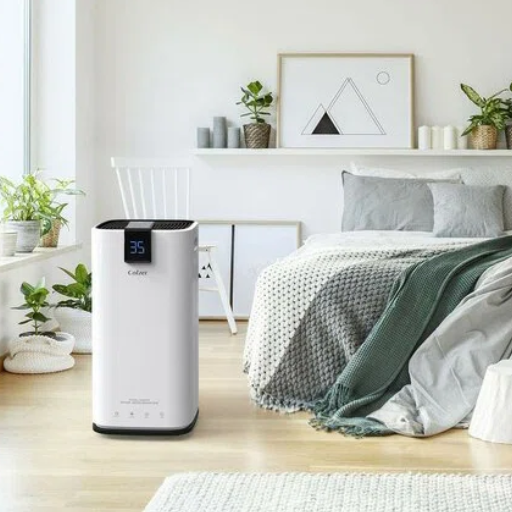
A dehumidifier is a vital device for ensuring indoor comfort and health. It removes excess moisture from the air to prevent mold and mildew, musty-smelling odors, and structural damage from forming in your home. Unlike a humidifier, which adds moisture to the air, a dehumidifier extracts moisture making it suitable for spaces with high humidity such as basements. Also, dehumidifiers help with improving air quality, reducing the risk of respiratory problems and allergies. Most importantly, dehumidifiers make it easy to maintain a comfortable living space.
Identifying Signs of High Humidity in Your Home
Windows and glass surfaces started showing condensation, which was one of the first signs I noticed. Along with that, there was a combination of a deep musty smell in the air which means that there was too much moisture. As I progressed, I realized that some clothes and even some upholstered furniture felt damp and I started spotting mildew or mold in the corners of walls and other harder-to-reach spots. I also started experiencing more allergy problems which indicated to me how a dehumidifier would help improve the air quality.
How Excess Moisture Leads to Mold and Mildew
Mold and mildew thrive in places with excess moisture because this is where they can extract the damp conditions needed to grow. In my experience, when there is concentrated humidity, or water is present in excess, surfaces like walls, ceilings, and fabrics absorb moisture and become favorable for mold growth. The moment spores land on these damp surfaces, they can reproduce at a rapid pace which leads to their visible growth and the musty odor associated with mold. The process is only further accelerated by a lack of ventilation and long exposure which is why humidity levels must be resolved quickly.
Improving Indoor Air Quality with a Dehumidifier
Using a dehumidifier is an effective way to improve indoor air quality by reducing excess moisture and preventing mold growth. When selecting a dehumidifier, consider the following key parameters:
- Capacity: Measure in pints per day (PPD); a 30–50 PPD dehumidifier is suitable for small to medium-sized rooms, while 50+ PPD is ideal for basements and larger spaces.
- Area Coverage: Match the dehumidifier’s coverage area (in square feet) to your room size to ensure optimal performance.
- Humidity Levels: Aim to maintain indoor humidity between 30–50% for comfort and mold prevention.
- Energy Efficiency: Look for Energy Star-certified models to save on electricity costs while maintaining performance.
- Tank Size and Draining: Choose a larger tank for less frequent emptying or models with continuous drainage for convenience.
A properly selected and maintained dehumidifier can significantly enhance air quality, reduce allergens, and create a healthier indoor environment.
Choosing the Right Dehumidifier for Your Space
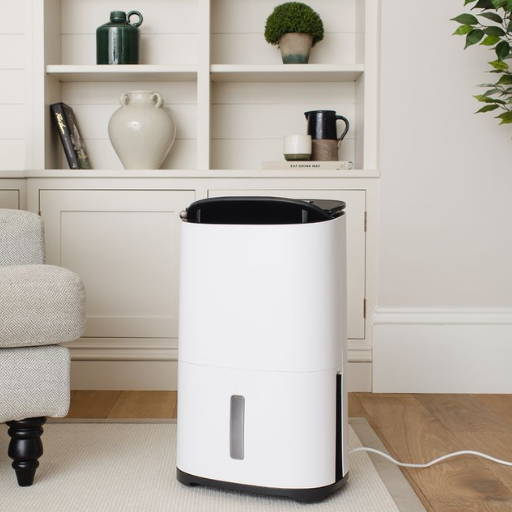
Finding the correct dehumidifier for a space may require consideration of its specific needs. For instance, portable dehumidifiers with lower capacities work well in smaller rooms, while basements may require a higher-capacity unit. Also, the level of humidity and space available are critical elements to consider; always estimate the coverage you’ll need. Energy savings are another crucial aspect, and devices marked with Energy Star labels are most efficient because they consume less electricity. Additionally, adjustable humidistats, automatic shut-off features, and easy-to-clean filters assist in providing comfort and long-term maintenance. A clear understanding of your personal needs gives you the ability to ensure a working dehumidifier.
Determining the Capacity Dehumidifier You Need
Knowing what to look for in humidity levels is the first step to estimating the coverage a device would need. For smaller areas, like bathrooms or bedrooms with slight humidity, a 20-30 pint capacity will suffice. If dealing with larger spaces, such as basements or significantly moisture-laden rooms, a unit with a capacity of 40-70 pints would work best. These, alongside other features, especially energy-saving ones add to the effectiveness of the unit. In the end, total moisture control is the built goal after picking the right capacity.
Comparing Compressor Dehumidifier vs. Desiccant Dehumidifier
In my analysis of the appropriateness of a compressor dehumidifier and a desiccant dehumidifier, I have found that the selection is rather dependent on the surrounding area and particular requirements. A compressor dehumidifier is most efficient at extracting moisture from the air, which makes it ideal for operation within warmer and humid conditions since it can economically operate. They are generally less energy inefficient because of the refrigerant system that they employ to draw moisture from the air, particularly for spaces with temperatures above 60°F (15°C). Desiccant dehumidifiers, however, have the advantage of cooler climates since they can operate at temperatures as low as 32°F (0°C), because they depend on adsorbent material to extract moisture. Although quieter, they tend to spend more energy in contrast.
Technical Parameters to Consider:
- Compressor Dehumidifier:
-
- Optimal Operating Temperature Range: 59-86°F (15-30°C)
- Energy Usage: Lower, typically around 300-600 Watts
- Noise Level: 35-50 dB
- Suitable for Warm Climates
- Desiccant Dehumidifier:
-
- Optimal Operating Temperature Range: 32-59°F (0-15°C)
- Energy Usage: Higher, typically 600-700 Watts
- Noise Level: 30-40 dB
- Suitable for Cold Climates
For my personal preference, I’d likely go with a compressor dehumidifier for energy savings in warmer rooms but would consider a desiccant unit for effective moisture control in colder seasons or spaces like garages or unheated basements.
Finding a Dehumidifier for Your Basement
In the process of selecting a dehumidifier for your basement, certain intricate details such as the overall size of the basement, the level of humidity, and temperature should be taken into account. Below is a simple summary that gives an understanding at a glance from all available resources:
- Consider the Size of Your Basement: Calculate both the square footage and humidity level. For large basements or spaces with high humidity (above 60%), a more powerful dehumidifier, enabling higher extraction levels of 50-70 pints/day may be needed. For smaller basements or moderately humid spaces (between 40-60%), more reasonable 20-30 pint units work well.
- Check the Temperature: For warm basements, over 60F, a compressor dehumidifier works the best since it’s the most energy efficient. For colder basements or unheated spaces, desiccant dehumidifiers are better suited as they work effectively at low temperatures.
- Features to Look For:
-
-
- Drainage Options: A built-in pump or hose connection can ease water removal, especially for continuous use.
- Energy Efficiency: Look for Energy Star-certified models to save on electricity bills.
- Noise Levels: Depending on placement, quieter models (30-40 dB) may be preferred.
-
Ultimately, the choice depends on your specific needs and environment. Assessing these factors ensures optimal performance while maintaining energy efficiency.
How to Properly Use a Dehumidifier

When employing a dehumidifier, one of the first things to do is to determine the ideal location in which the unit will serve best. This is usually in a room where there are no walls, furniture, and other obstructions that are likely to restrict the flow of air to and from the unit. Do make sure that the doors and windows are sealed to keep outside humidity from interfering with the dehumidifier’s functions. A setting of around 30-50% humidity is deemed most comfortable and helps avoid mold formation; thus, set the humidistat to obtain the desired level of moisture. If possible, adjust the water tank to a continuous drain hose to help with overflow control. In addition to emptying the water tank, check or change the filter periodically to retain efficient air quality for the dehumidifier’s effective performance. In the end, the unit will serve you best when its manufacturer’s instructions relating to maintenance and care are strictly adhered to.
Optimal Humidity Level Settings for Your Home
At least in my experience, comfort is best maintained at a humidity level of 30 to 50%. This level will also help prevent issues such as mold growth and dryness. I do try to regularly check the built-in humidistat on my dehumidifier so that I can keep it within this range. To minimize hassle, I prefer a continuous drain hose, but if that isn’t possible, I remember to empty the water tank every day. Cleaning the filter on a monthly basis has been crucial in maintaining the freshness of the air as well as ensuring that the device works properly. I also suggest that you follow the manufacturer’s care guidelines to help your dehumidifier work efficiently for many years.
Best Practices for Running a Dehumidifier
To allow the dehumidifier to function appropriately, place it in an area with good airflow, like a basement or a room that has high humidity. Also remember to keep the windows and doors closed during the operation so as not to let excess moisture enter. For maximum comfort and effectiveness set the humidity level within a range of 30-50%. Also, routinely empty the water tank or ensure that the drain hose is not blocked. For maintenance, clean the filter, exterior, and drainage systems monthly, and don’t forget to check for any clogs. For everything else, check the user manual for your model.
Maintenance Tips to Ensure Your Dehumidifier Lasts
- Regular Cleaning of the Coils is Imperative
Dirt and dust can settle on the coils which makes the device less efficient. Therefore, it is recommended to use a soft brush or a vacuum every couple of months to clean them.
- Check and Replace the Filter
In addition to trapping dust and allergens, air filters also get clogged. When they do, the device creates unnecessary strain on the unit. To avoid this, you must check the filter at least once every month, and replace it if necessary to allow air to circulate freely.
- Inspect the Hose and Drainage System
For dehumidifiers utilizing continuous drainage, make sure there are no kinking, blockage, or leaks present in the hose. An unblocked drainage system ensures smooth water flow without any blockage or overflow.
- Enhancing Optimal Placement
The dehumidifier should be placed in a room where airflow is freely circulating without any obstacles like walls or furniture for more than 12 inches. The device should not be placed in areas where there are extreme weather ranges and heat sources.
- Store Correctly During Off-Seasons
The dehumidifier should be cleaned thoroughly and dried if it is not intended to be used for long periods. To prevent damage and mold growth, the device should be stored in a cool place.
These easy-to-follow steps along with your user manual should ensure your dehumidifier runs effortlessly for many years.
Common Issues and Troubleshooting Your Dehumidifier
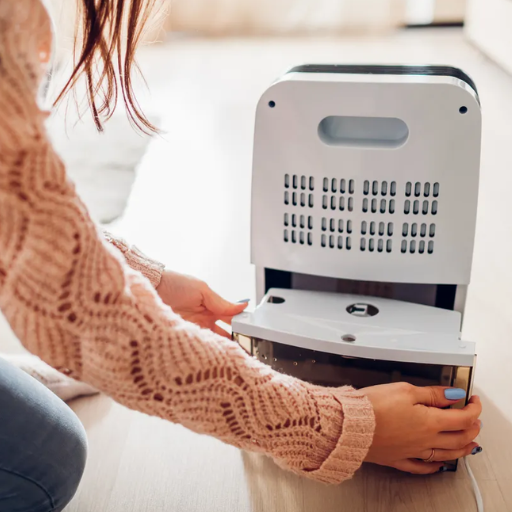
To tackle typical dehumidifier problems, there is some level of troubleshooting to be done. For instance, if the unit does not turn on, check its power connection, and make sure the water tank is properly seated and empty. If it does not extract moisture, confirm that the room doors and windows are closed, the air filter is clean or replaced, and the room temperature is above 41°F (5°C). To avoid overflowing, the tank should be emptied regularly, and checked with the float switch, and the drain hose, if supported, should be checked. If the unit operates with unusual noise and vibrations, it may be due to improper placement of the unit, or some loose parts within the unit; make sure it is on a stable, flat surface and check for some debris. The frost build-up on coils can be minimized by using the dehumidifier in the warmest rooms and using the defrost feature if there is one. To prevent bad smells due to poor quality of air, the water tank and the air filter should be replaced regularly. These measures can enhance the dehumidifier’s performance and effectiveness, but further obsessive behavior may be needed if the problem remains such as referring to the manual or calling customer support.
Dealing with Condensation and Water Leaks
To successfully manage condensation and water leaks, I make sure my dehumidifier is on a stable flat surface, and all seals or connections are properly secured. In instances where excessive water is collecting, I check to see if the drain hose is clogged or set up incorrectly, and also make sure that the float switch is not stuck. To solve condensation issues, I check to see if the humidity settings are correct for the room, and ensure there is unobstructed airflow around the unit perimeter. Regular cleaning of the water tank and air filter also assists in leak prevention while maximizing the performance of the dehumidifier. Should these measures prove ineffective, I default to the manufacturer instructions on the website or reach out for customer support.
Understanding Water Reservoir Maintenance
To care for my dehumidifier, I routinely empty the water reservoir to avoid excess fill, overflow, and mold or bacteria forming. I clean it using a mild soap and warm water and rinse thoroughly every week. I also examine the reservoir for any fractures or damages that could lead to leakage. These steps ensure that my dehumidifier’s reservoir stays clean and keeps the dehumidifier functioning optimally.
When to Consider Buying a Dehumidifier Replacement
Replacing my dehumidifier comes to mind if it stops extracting moisture, becomes too costly in repairs, or starts showing symptoms of wear such as leaking or strident noises. Furthermore, some older models are not energy efficient, making new units more affordable in the long run. Other things I look for when checking the unit are: capacity in pints per day, energy use effectiveness (like an Energy Star certification), and how well it suits the room size for the replacement. Typically, if the unit is over five to ten years old and the repairs required would cost over fifty percent of the new unit’s cost, then substituting the unit is a more beneficial option long-term.
References
Frequently Asked Questions (FAQ)
Q: What are the two main types of dehumidifiers, and how do they work?
A: The two main types of dehumidifiers are refrigerant dehumidifiers and desiccant dehumidifiers. A refrigerant dehumidifier works by drawing moist air over a refrigerated coil, causing the moisture to condense into water, which is collected in a tank. The dry air is then reheated and released back into the room. A desiccant dehumidifier uses a moisture-absorbing material to extract water vapor from the air, making it effective in lower temperatures.
Q: How do I determine the right size dehumidifier for my home?
A: To choose the best dehumidifier for your space, you need to consider the size of the area and the humidity level in your home. Measure the square footage of the area and assess how damp it is. Most dehumidifiers include guidelines for room size and moisture levels, helping you select the appropriate capacity.
Q: What are the signs you need a dehumidifier in your home?
A: Signs you may need a dehumidifier include persistent dampness, visible mold or mildew, condensation on windows, musty odors, and increased allergy symptoms due to dust mites. If you notice these issues, a dehumidifier can help improve your air quality.
Q: How does a whole-home dehumidifier differ from a portable unit?
A: A whole-home dehumidifier is integrated into your home’s HVAC system and works to remove moisture from the air throughout your entire house. In contrast, a portable unit is designed to dehumidify a single room or small area. Whole-home systems are more efficient for comprehensive humidity control.
Q: Can an air conditioner replace a dehumidifier?
A: While an air conditioner can help remove some moisture from the air as it cools, it is not as effective as a dedicated dehumidifier at controlling humidity levels. If your primary concern is reducing humidity, a dehumidifier is a better choice.
Q: How does a dehumidifier help in preventing water damage?
A: A dehumidifier can help prevent water damage by reducing excess moisture in areas of your home prone to dampness, such as basements and bathrooms. By maintaining a lower humidity level, it minimizes the risk of mold, mildew, and structural damage caused by excess moisture.
Q: What is the ideal humidity level in your home?
A: The ideal humidity level in your home is between 30% and 50%. Maintaining this range helps protect your home and health by preventing mold growth and reducing allergens like dust mites.
Q: How often should you run the dehumidifier?
A: The frequency of operating a dehumidifier depends on the humidity level and conditions inside your home. During damp seasons or in particularly humid areas, you may need to run the dehumidifier continuously. In milder conditions, intermittent use might be sufficient.
Q: What maintenance is required for a dehumidifier?
A: Regular maintenance for a dehumidifier includes cleaning or replacing the air filter, emptying the water collection tank, checking the coils for frost or debris, and ensuring the unit’s vents are clear. Proper maintenance ensures the dehumidifier operates efficiently.

